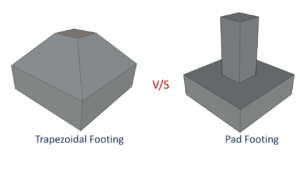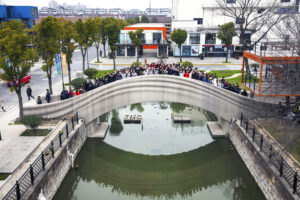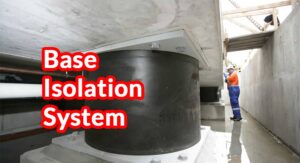
Top 50 Civil Engineering Questions & Answers

Question 1.What is a flat slab?
Answer:
A flat slab is a two-way reinforced concrete slab that usually does not have beams and girders, and the loads are transferred directly to the supporting concrete columns. For more detailed definition: Flat Slab Floor System : Definition & Description.
Question 2. What is footing in civil engineering?
Answer:
The term footing is used in conjunction with shallow foundations commonly. A footing is a foundation unit constructed in brick work, masonry or concrete under the base of a wall or a column for the purpose of distributing the load over a large area.
Question 3. What is a coffer slab?
Answer:
Question 4. What is a stem wall?
Answer:
Basement Slab. Basics. The foundation is the part of the structure that contacts the earth. … Recreational home built in the mountains or on the beach are often constructed on pier foundations. There are four popular types of foundations that are used: Basements, crawlspaces, Monolithic slab and stem wall slab.
Question 5. What is a flat plate of the abdomen?
Answer :
Flat plate of the abdomen, KUB, plain film of the abdomen. Common Use: To visualize and assess the abdominal organs for obstruction or abnormality related to mass, trauma, bleeding, stones, or congenital anomaly. Area Of Application: Kidneys, ureters, bladder, and abdomen.
Question 6. What is a spread foundation?
Answer :
Spread Footings. Square or rectangular shaped blocks of reinforced concrete that typically support a single column or wall of a building. The allowable bearing pressure on the soil determines the size of the spread footing.
Question 7. What is a mat foundation?
Answer :
Question 8. What is a waffle raft slab?
Answer :
Question 9. What is the use of pile foundation?
Answer:
Question 10. What is open foundation?
Answer:
Open Foundation is a tertiary preparation program offered by the University of Newcastle for people who have been out of the education system for some time, and who hope to study in an undergraduate degree program in the future.
Question 11. What is the use of plinth beam?
Answer :
You can see here the beam is constructed at ground level. The void between the foundation and plinth level is filled with compacted soil. Brick or stone masonry is usually constructed below the plinth beam. The plinth beam needs to be strong, but need not be made up of reinforced cement concrete (RCC) all the time.
Question 12. What is ductility?
Answer :
Ductility is Known as the ability to deform under tensile stress
Question 13. What are the types of a slump?
Answer :
- True Slump:After the test, the concrete is evenly spread and there is no disintegration in the shape of a slump.
- Shear Slump:Here one side of the slump slides down the other is known as shear slump, it is formed by a lean concrete mix.
- Collapse Slump:The slump fails or collapses due to excessive water, it is known as a collapse slump.
- Zero Slump: For very stiff and dry mixes, the sample doesn’t change it”s shape is known as zero slump.
Question 14. What does monolithic slab mean?
Answer :
Monolithic slabs are foundation systems constructed as one single concrete pour that consists of a concrete slab with thickened portions of the slab under load bearing walls and all perimeter edges that take the place of footers.
Question 15. What is span in civil engineering?
Answer :
Span is the distance between two intermediate supports for a structure, e.g. a beam or a bridge. A span can be closed by a solid beam or by a rope. The first kind is used for bridges, the second one for power lines, overhead telecommunication lines, some type of antennas or for aerial tramways.
Question 16. What is a beam and column?
Answer :
If you keep it horizontally it is called a Beam which carries the loads by bending, simply called flexure. If you keep it vertically forms a Column which carries load by undergoing compression. If you keep it in an inclined fashion it is called a Strut which carries horizontal and vertical components of forces.
Question 17. Can you put concrete on concrete?
Answer :
Yes, you can pour new concrete over top of the old, but here are some things to keep in mind. If your new slab will be larger than the old building, you need to be careful about cracks mirroring through around the perimeter of the old building. I would recommend using some extra rebar in these areas.
Question 18. What is a frost wall?
Answer :
A frost wall is a type of wall that adds no structural integrity to the building, but acts as an insulator. It is typical to see frost walls placed in basements since most basements are made of nothing more than cement and brick, which does not provide much insulation.
Question 19.What is floating in concrete?
Answer :
A concrete float is a tool used to finish a concrete surface by making it smooth. Afloat is used after the surface has been made level using a screed. In addition to removing surface imperfections, floating will compact the concrete as preparation for further steps.
Question 20. What is a pile mat?
Answer :
A pile cap is a thick concrete mat that rests on concrete or timber piles that have been driven into soft or unstable ground to provide a suitable stable foundation. It usually forms part of the foundation of a building, typically a multi-story building, structure or support base for heavy equipment.
Question 21. What is Coffering used for?
Answer :
A coffer (or coffering) in architecture, is a series of sunken panels. in the shape of a square, rectangle, or octagon in a ceiling, soffit or vault.
Question 22. What is a waffle slab?
Answer :
Resembling the food after which they are named, concrete waffle slabs are reinforced concrete floors and roofs that use a square grid of deep sides. This form of construction is used in airports, parking garages, commercial and industrial buildings, bridges, residences and other structures requiring extra stability.
Question 23. What is a continuous footing?
Answer :
A strip footing is a type of shallow foundation which is provided for the load bearing wall and for economy purpose, in row of columns which are so closely spaced that their spread footing overlap or nearly touch each other. Strip footing is also know as continuous footing.
Question 24. How deep should the footing be?
Answer :
The projection of the footing on either side of the wall is supposed to be no greater than the depth of the footing. The bottom of the footing should be at least 12″ below the finished grade line (surface of the ground). It may need to be deeper. It must be below the frost line.
Question 25. What is the slump test?
Answer :
The slump test is a means of assessing the consistency of fresh concrete. It is used, indirectly, as a means of checking that the correct amount of water has been added to the mix. The test is carried out in accordance with BS EN 12350-2,Testing fresh concrete.
Question 26. What is a pier in construction?
Answer :
Pier, in building construction, vertical load bearing member such as an intermediate support for adjacent ends of two bridge spans. In foundations for large buildings,piers are usually cylindrical concrete shafts, cast in prepared holes, while in bridges they take the form of caissons, which are sunk into position.
Question 27. What is Slipform paver?
Answer :
Slipform paving is defined as a process used to consolidate, form into geometric shape and surface finish a PCC mass by pulling the forms continuously through and surrounding the plastic concrete mass.
Question 28. What is meant by punching shear?
Answer :
Punching shear is a type of failure of reinforced concrete slabs subjected to high localized forces. In flat slab structures this occurs at column support points. The failure is due to shear.
Question 29. What is a strip foundation?
Answer :
Strip foundations are used where the soil is of good bearing capacity. The key sizes of a strip foundation for concrete cavity wall construction and timber frame cavity wall construction are similar. … The depth of a strip foundation must be equal to or greater than the overall width of the wall.
Question 30. What is a suspended floor?
Answer :
A suspended Floor is a specialist construction made of a solid concrete Floor, a system of sleeper walls and timber joists, upon which sits a supported timber floor.
Question 31. WWhat is a caisson pile?
Answer :
A pile machine in Amsterdam, the Netherlands. Also called caissons, drilled shafts, drilled piers, Cast-in-drilled-hole piles (CIDH piles) or Cast-in-Situ piles, a borehole is drilled into the ground, then concrete (and often some sort of reinforcing) is placed into the borehole to form the pile.
Question 32. What is the single span bridge?
Answer :
A ‘span’ in engineering parlance means ‘the gap between two supports’ This bridge is single span: A single span slab is a slab that is supported at either end.
Question 33. What is a frost wall?
Answer :
A frost wall is a type of wall that adds no structural integrity to the building, but acts as an insulator. It is typical to see frost walls placed in basements since most basements are made of nothing more than cement and brick, which does not provide much insulation.
Question 34. What is the combined footing?
Answer :
It is used when the two column are so close to each other that their individual footings would overlap. A combined footing is also provided when the property line is so close to one column that a spread footing would be eccentrically loaded when kept entirely within the property line.
Question 35. What is the function of a foundation?
Answer :
Foundation is the lower portion of the building usually located below ground level, which transmits the loads of the super structure to the supporting soil. A foundations therefore that part of the structure which is in direct contact with the ground to which loads are transmitted.
Question 36. What is a tilt up?
Answer :
Tilt-up, tilt-slab or tilt-wall is a type of building and a construction technique using concrete. Though it is a cost-effective technique with a shorter completion time, poor performance in earthquakes has mandated significant seismic retrofit requirements in older buildings.
Question 37. What is slip form construction?
Answer :
Slip forming, continuous poured, continuously formed, or slipform construction is a construction method in which concrete is poured into a continuously moving form. Slip forming is used for tall structures (such as bridges, towers, buildings, and dams), as well as horizontal structures, such as roadways.
Question 38. What is hollow core plank?
Answer :
Question 39. What is two way shear?
Answer :
Question 40. What is punching shear in flat slabs?
Answer :
Question 41. What is a suspended floor?
Answer :
Punching shear is a type of failure of reinforced concrete slabs subjected to high localized forces. In flat slab structures this occurs at column support points. The failure is due to shear.
Question 42.What are the different types of beams?
Answer :
Common types of beams include simply supported beams, cantilever beams, overhanging beams, fixed beams, and continuous beams.
Question 43. What is a bearing capacity of soil?
Answer :
Bearing capacity is the capacity of soil to support the loads applied to the ground by the foundation of the structure.
Question 44. Explain what is flashing?
Answer :
Flashing is an extended construction that is done to seal and protects joints in a building from water penetration. Flashing is installed at the intersecting roofs, walls and parapets.
Question 45. What is Shear slump ?
Answer :
Shear slump implies that the concrete mix is deficient in cohesion. Consequently, it may undergo segregation and bleeding and thus is undesirable for durability of concrete.
Question 46. The bearing capacity of granite is generally ?
Answer :
30 to 35 kg/cm 2
Question 47. What are the uses of Groynes ?
Answer :
They prevent, or slow down erosion, and stop the longshore drift. This, however, can have bad knock-on effects somewhere near.
Question 48. Explain QA&QC ?
Answer :
Quality Assurance (QA): Quality Assurance is a set of activities for ensuring quality in the processes by which works are done. Quality Assurance is the process of managing for quality.
Quality Control (QC): Quality Control is a set of activities for ensuring quality in works. The activities focus on identifying defects in the actual products produced. Quality Control is used to verify the quality of the output.
Question 49. What Is The Ratio Of Grades M5, M7.5, M10, M15, M20, M25, M30, M35, M40?
Answer :
M5 – 1:5:10
M7.5 – 1:4:8
M10 – 1:3:6
M15 – 1:2:4
M20 – 1:1.5:3
M25 – 1:1:2
M30, M35, M40 – Design Mix Followed
Question 50. How Do You Determine Specific Gravity Of Cement?
Answer :
Cement is usually purchased as a powdery substance that is mixed with sand, aggregate, gravel, and water to form concrete. Since the cement itself is usually a powder, it is hard to measure a standard value for its specific gravity. In addition, since cement is usually not used by itself, knowing its specific gravity is not Particularly useful.
A more useful question is “What is the typical density of concrete?” A rule of thumb answer is that normal cured concrete has a density of about 150 pounds per cubic foot. This includes the weight of the cement, sand, aggregate, and that PArt of the water that chemically binds with the cement to form the concrete. Since water weighs about 62.4 pounds per cubic feet, concrete is about 2.4 times as heavy. Thus, the specific gravity of concrete is about 2.4. If you took cement and mixed it with water, you would eventually have a hard lump of useless cement and it would also have a specific gravity of between 2 and 2.4.




